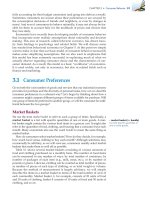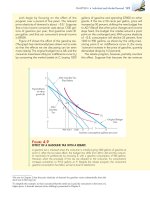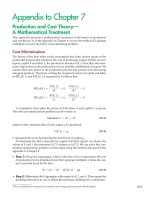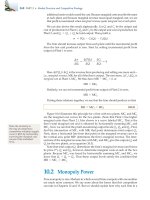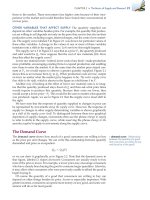(8th edition) (the pearson series in economics) robert pindyck, daniel rubinfeld microecon 111
Bạn đang xem bản rút gọn của tài liệu. Xem và tải ngay bản đầy đủ của tài liệu tại đây (136.45 KB, 1 trang )
86 PART 2 • Producers, Consumers, and Competitive Markets
line) is unchanged. The same is true for food. Therefore, inflationary conditions
in which all prices and income levels rise proportionately will not affect the
consumer’s budget line or purchasing power.
3.3 Consumer Choice
Given preferences and budget constraints, we can now determine how individual
consumers choose how much of each good to buy. We assume that consumers
make this choice in a rational way—that they choose goods to maximize the satisfaction they can achieve, given the limited budget available to them. The maximizing
market basket must satisfy two conditions:
1. It must be located on the budget line.To see why, note that any market
basket to the left of and below the budget line leaves some income unallocated—income which, if spent, could increase the consumer’s satisfaction.
Of course, consumers can—and often do—save some of their incomes for
future consumption. In that case, the choice is not just between food and
clothing, but between consuming food or clothing now and consuming
food or clothing in the future. At this point, however, we will keep things
simple by assuming that all income is spent now. Note also that any market
basket to the right of and above the budget line cannot be purchased with
available income. Thus, the only rational and feasible choice is a basket on
the budget line.
2. It must give the consumer the most preferred combination of goods and
services.
These two conditions reduce the problem of maximizing consumer satisfaction
to one of picking an appropriate point on the budget line.
In our food and clothing example, as with any two goods, we can graphically
illustrate the solution to the consumer’s choice problem. Figure 3.13 shows how
F IGURE 3.13
MAXIMIZING CONSUMER
SATISFACTION
A consumer maximizes satisfaction
by choosing market basket A. At this
point, the budget line and indifference curve U2 are tangent, and no
higher level of satisfaction (e.g., market basket D) can be attained. At A,
the point of maximization, the MRS
between the two goods equals the
price ratio. At B, however, because
the MRS [−(−10/10) = 1] is greater
than the price ratio (1/2), satisfaction
is not maximized.
Clothing
(units per
week)
40
B
30
D
–10C
A
20
+10F
U3
U2
U1
Budget Line
20
40
80
Food
(units per week)

